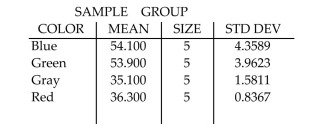An industrial psychologist is investigating the effects of work environment on employee attitudes. A group of 20 recently hired sales trainees were randomly assigned to one of four different ʺhome
Roomsʺ- five trainees per room. Each room is identical except for wall color. The four colors used
Were light green, light blue, gray, and red. The psychologist wants to know whether room color
Has an effect on attitude, and, if so, wants to compare the mean attitudes of the trainees assigned to
The four room colors. At the end of the training program, the attitude of each trainee was measured
On a 60-pt. scale (the lower the score, the poorer the attitude) . The data was subjected to a
One-way analysis of variance. 

Give the null hypothesis for the ANOVA F-test shown on the printout.
A) , where the
B) , where the represent attitude means for the th person in each room
C) , where the 's represent the proportion with the corresponding attitude
D) , where the 's represent the room colors
Correct Answer:
Verified
Q29: 307 diamonds were sampled and randomly
Q30: A multiple-comparison procedure for comparing four
Q31: A certain HMO is attempting to
Q32: Find the critical value
Q33: Find the critical value F0 for a
Q35: Given that the mean square for treatments
Q36: Which of the following is not a
Q37: In a completely randomized design experiment,
Q38: Given that the sum of squares for
Q39: 307 diamonds were sampled and randomly
Unlock this Answer For Free Now!
View this answer and more for free by performing one of the following actions

Scan the QR code to install the App and get 2 free unlocks

Unlock quizzes for free by uploading documents